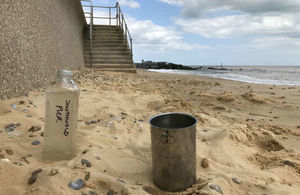
Sampling equipment on the beach at Southwold
The Environment Agency monitors water quality from May to September so you know how clean the water is when you swim or paddle.
Mark Mayston, an officer in the National Sampling and Collection team in East Anglia, who has worked for the Environment Agency for 16 years, covers part of the East Anglian coastline. His first stop to take a sample is in Felixstowe, Suffolk, then he travels onto Southwold, Lowestoft, and Gorleston, before finishing in Great Yarmouth.
He said:
I love sampling up and down this wind swept coastline. Around this time of year the beaches are usually busy and there's always someone with a question to ask. I'm pleased to be able to tell them what I'm doing and happy that my work is making a difference to them and the many thousands who visit the seaside every year.
Officers have to ensure sure they are standing as closed to the designated sample point as possible and fill up a bottle with sea water. This is stored in a fridge in the officer's van and is later taken to a laboratory where it undergoes bacteria analysis. A second sample is taken to measure the salt levels in the water.
They also note down supporting information, such as the number of bathers and beach users, if there is animal faeces and litter on the beach and the amount of seaweed present.
There are 4 water quality classifications Excellent, Good, Sufficient and Poor. These are set according to the level of bacteria in the water based on guidelines produced by the World Health Organisation to protect health. In 2018, 97.9% of bathing waters across the country met the tough standards. Results can be found at environmental data.






